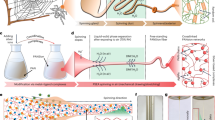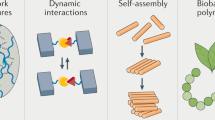Abstract
Shape-memory polymeric materials lack long-range molecular order that enables more controlled and efficient actuation mechanisms. Here, we develop a hierarchical structured keratin-based system that has long-range molecular order and shape-memory properties in response to hydration. We explore the metastable reconfiguration of the keratin secondary structure, the transition from α-helix to β-sheet, as an actuation mechanism to design a high-strength shape-memory material that is biocompatible and processable through fibre spinning and three-dimensional (3D) printing. We extract keratin protofibrils from animal hair and subject them to shear stress to induce their self-organization into a nematic phase, which recapitulates the native hierarchical organization of the protein. This self-assembly process can be tuned to create materials with desired anisotropic structuring and responsiveness. Our combination of bottom-up assembly and top-down manufacturing allows for the scalable fabrication of strong and hierarchically structured shape-memory fibres and 3D-printed scaffolds with potential applications in bioengineering and smart textiles.
This is a preview of subscription content, access via your institution
Access options
Access Nature and 54 other Nature Portfolio journals
Get Nature+, our best-value online-access subscription
$29.99 / 30 days
cancel any time
Subscribe to this journal
Receive 12 print issues and online access
$259.00 per year
only $21.58 per issue
Buy this article
- Purchase on Springer Link
- Instant access to full article PDF
Prices may be subject to local taxes which are calculated during checkout




Similar content being viewed by others
Data availability
All produced data that support this study are included in this published article and its supplementary information files. Data points for the mechanical tests are provided as source data files. Additional data are available from the corresponding author upon request. Source data are provided with this paper.
References
Cladera, A. et al. Iron-based shape memory alloys for civil engineering structures: an overview. Constr. Build. Mater. 63, 281–293 (2014).
L. Santo, L., Quadrini, F., Accettura, A. & Villadei, W. Shape memory composites for self-deployable structures in aerospace applications. Procedia Eng. 88, 42–47 (2014).
Hu, J., Meng, H., Li, G. & Ibekwe, S. I. A review of stimuli-responsive polymers for smart textile applications. Smart Mater. Struct. 21, 053001 (2012).
Opie, N. L. et al. Focal stimulation of the sheep motor cortex with a chronically implanted minimally invasive electrode array mounted on an endovascular stent. Nat. Biomed. Eng. 2, 907–914 (2018).
Montgomery, M. et al. Flexible shape-memory scaffold for minimally invasive delivery of functional tissues. Nat. Mater. 16, 1038–1046 (2017).
Liu, C., Qin, H. & Mather, P. T. Review of progress in shape-memory polymers. J. Mater. Chem. 17, 1543–1558 (2007).
Peterson, G. I., Dobrynin, A. V. & Becker, M. L. Biodegradable shape memory polymers in medicine. Adv. Healthc. Mater. 6, 1700694 (2017).
Lendlein, A. & Gould, O. E. C. Reprogrammable recovery and actuation behaviour of shape-memory polymers. Nat. Rev. Mater. 4, 116–133 (2019).
Fischer, F. D., Harrington, M. J. & Fratzl, P. Thermodynamic modeling of a phase transformation in protein filaments with mechanical function. New J. Phys. 15, 065004 (2013).
Fudge, D. S., Gardner, K. H., Forsyth, V. T., Riekel, C. & Gosline, J. M. The mechanical properties of hydrated intermediate filaments: insights from hagfish slime threads. Biophys. J. 85, 2015–2027 (2003).
Miserez, A. & Guerette, P. A. Phase transition-induced elasticity of α-helical bioelastomeric fibres and networks. Chem. Soc. Rev. 42, 1973–1995 2013).
Falk, W. & James, R. D. Elasticity theory for self-assembled protein lattices with application to the martensitic phase transition in bacteriophage T4 tail sheath. Phy. Rev. E 73, 011917 (2006).
Miserez, A., Wasko, S. S., Carpenter, C. F. & Waite, J. H. Non-entropic and reversible long-range deformation of an encapsulating bioelastomer. Nat. Mater. 8, 910–916 (2009).
Latorre, E. et al. Active superelasticity in three-dimensional epithelia of controlled shape. Nature 563, 203–208 (2018).
Xiao, X. & Hu, J. Animal hairs as water-stimulated shape memory materials: mechanism and structural networks in molecular assemblies. Sci. Rep. 6, 26393 (2016).
Tian, T. et al. A body temperature and water-induced shape memory hydrogel with excellent mechanical properties. Polym. Chem. 10, 3488–3496 (2019).
Alavijeh, R. Z., Shokrollahi, P. & Barzin, J. A thermally and water activated shape memory gelatin physical hydrogel, with a gel point above the physiological temperature, for biomedical applications. J. Mater. Chem. B 5, 2302–2314 (2017).
Gu, X. & Mather, P. T. Water-triggered shape memory of multiblock thermoplastic polyurethanes (TPUs). RSC Adv. 3, 15783–15791 (2013).
Khoury, L. R. & Popa, I. Chemical unfolding of protein domains induces shape change in programmed protein hydrogels. Nat. Commun. 10, 5439 (2019).
Guo, Y. et al. A biodegradable functional water-responsive shape memory polymer for biomedical applications. J. Mater. Chem. B 7, 123–132 (2019).
Popescu, C. & Höcker, H. Hair—the most sophisticated biological composite material. Chem. Soc. Rev. 36, 1282–1291 (2007).
Mandelkern, L., Halpin, J. C., Diorio, A. F. & Posner, A. S. Dimensional changes in fibrous macromolecules: the system α-keratin-lithium bromide. J. Am. Chem. Soc. 84, 1383–1391 (1962).
Whitesides, G. M., Lilburn, J. E. & Szajewski, R. P. Rates of thiol-disulfide interchange reactions between mono- and dithiols and Ellman’s reagent. J. Org. Chem. 42, 332–338 (1977).
Davidson, P., Penisson, C., Constantin, D. & Gabriel, J.-C. P. Isotropic, nematic, and lamellar phases in colloidal suspensions of nanosheets. Proc. Natl Acad. Sci. USA 15, 6662–6667 (2018).
Schwierz, N., Horinek, D. & Netz, R. R. Anionic and cationic Hofmeister effects on hydrophobic and hydrophilic surfaces. Langmuir 29, 2602–2614 (2013).
Bello, J. & Bello, H. R. Interaction of model peptides with water and lithium bromide. Nature 190, 440–441 (1961).
Abitbol, T., Kam, D., Levi-Kalisman, Y., Gray, D. G. & Shoseyov, O. Surface charge influence on the phase separation and viscosity of cellulose nanocrystals. Langmuir 34, 3925–3933 (2018).
Luo, D., Scott, S. W. & Anderson, B. D. Kinetics and mechanism of the reaction of cysteine and hydrogen peroxide in aqueous solution. J. Pharm. Sci. 94, 304–316 (2005).
Rintoul, L., Carter, E. A., Stewart, S. D. & Fredericks, P. M. Keratin orientation in wool and feathers by polarized Raman spectroscopy. Biopolymers 57, 19–28 (2000).
Kreplak, L., Doucet, J., Dumas, P. & Briki, F. New aspects of the α-helix to β-sheet transition in stretched hard α-keratin fibers. Biophys. J. 87, 640–647 (2004).
Busson, B., Briki, F. & Doucet, J. Side-chains configurations in coiled coils revealed by the 5.15-Å meridional reflection on hard α-keratin X-ray diffraction patterns. J. Struct. Biol. 125, 1–10 (1999).
Kim, J.-H. et al. Review of nanocellulose for sustainable future materials. Int. J. of Precis. Eng. and Manuf.–Green Tech. 2, 197–213 (2015).
Paquin, R. & Colomban, P. Nanomechanics of single keratin fibres: a Raman study of the α-helix→β-sheet transition and the effect of water. J. Raman Spectrosc. 38, 504–514 (2007).
Adams, W. W. & Eby, R. K. High-performance polymer fibers. MRS Bull. 12, 22–26 (1987).
Guo, C. et al. Structural comparison of various silkworm silks: an insight into the structure–property relationship. Biomacromolecules 19, 906–917 (2018).
Pang, B. et al. Design and preparation of a new polyurea-polysiloxane–polyether copolymer with a block soft segment prepared by utilizing aza-Michael addition reaction. Polym. Chem. 9, 869–877 (2018).
Kolesky, D. B. et al. 3D bioprinting of vascularized, heterogeneous cell-laden tissue constructs. Adv. Mater. 26, 3124–3130 (2014).
Acknowledgements
We thank the Wyss Institute for Biologically Inspired Engineering at Harvard University for ongoing support throughout this project. We also thank the Center for Nanoscale Systems at Harvard University, in particular S. Stoilova-McPhie and A. McClelland for their assistance in the use of the cryo-TEM and Raman spectrometer, respectively. The Center for Nanoscale Systems is a member of the National Nanotechnology Infrastructure Network, which is supported by the National Science Foundation under award no. 1541959. This work was partially funded by the Materials Research Science and Engineering Center of Harvard University under National Science Foundation award no. DMR-1420570. We thank the X-ray Diffraction Shared Experimental Facility at the Massachusetts Institute of Technology, and in particular C. Settens for his assistance during the WAXS experiments. We thank M. Rosnach for his graphic design support. SAXS experiments were supported by the Korean Atomic Energy Research Institute through National Research Foundation grant nos. 2017M2A2A6A01071190 and 2018R1A2B3001690. Finally, we acknowledge the financial support from the Basic Science Research Program of the National Research Foundation (grant nos. 2018R1A6A1A03024940 and 2019R1A2C2084638), which is funded by the Ministry of Science and ICT (Information and Communication Technology) of Korea.
Author information
Authors and Affiliations
Contributions
L.C. and K.K.P. conceived and designed the work. L.C. implemented the keratin extraction, fibre spinning and 3D printing protocols. J.L., M.C.C. and K.S. conducted the SAXS experiments and related data analysis and interpretation. G.M.G. and Q.L. carried out the rheological measurements and related data analysis. C.O.C., G.M.G. and L.C. carried out the tensile tests. L.C. conducted the Raman spectroscopy, polarized light microscopy, SDS–PAGE, WAXS, circular dichroism spectrometry, SEM, cryo-TEM and related data analysis and interpretation. S.C. and R.G. designed the 3D-printed structures. L.C. wrote the manuscript. Q.L., G.M.G., C.O.C., K.S. and K.K.P. edited the manuscript. All authors discussed the results.
Corresponding author
Ethics declarations
Competing interests
The authors declare no competing interests.
Additional information
Publisher’s note Springer Nature remains neutral with regard to jurisdictional claims in published maps and institutional affiliations.
Supplementary information
Supplementary Information
Supplementary Videos 1 and 2 captions, Figs. 1–11, Table 1 and refs. 1–15.
Supplementary Video 1
Shape-memory fibres
Supplementary Video 2
Shape-memory 3D-printed scaffolds
Supplementary Data 1
Additional source data of tensile tests
Source data
Source Data Fig. 3b,h,i
Source Data Tensile Tests
Rights and permissions
About this article
Cite this article
Cera, L., Gonzalez, G.M., Liu, Q. et al. A bioinspired and hierarchically structured shape-memory material. Nat. Mater. 20, 242–249 (2021). https://doi.org/10.1038/s41563-020-0789-2
Received:
Accepted:
Published:
Issue Date:
DOI: https://doi.org/10.1038/s41563-020-0789-2
This article is cited by
-
Bioinspired structural hydrogels with highly ordered hierarchical orientations by flow-induced alignment of nanofibrils
Nature Communications (2024)
-
Textile production by additive manufacturing and textile waste recycling: a review
Environmental Chemistry Letters (2024)
-
Cellulose based hierarchically structured anion-exchange fiber for efficient dye adsorption
Cellulose (2024)
-
Protein fibers with self-recoverable mechanical properties via dynamic imine chemistry
Nature Communications (2023)
-
Water-responsive supercontractile polymer films for bioelectronic interfaces
Nature (2023)



